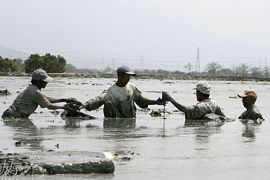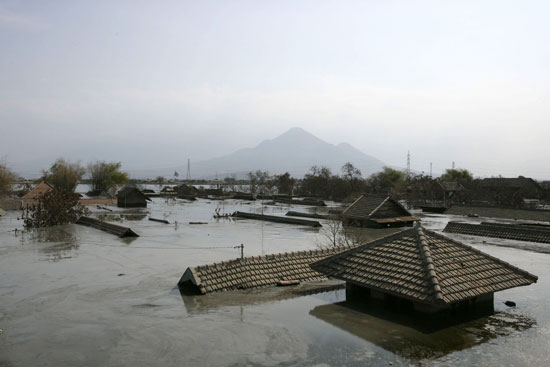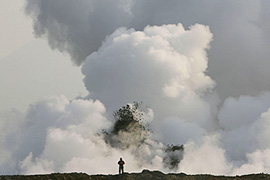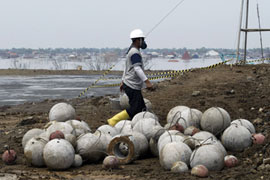Balls dropped into Java mud volcano
Chained concrete balls dropped into Java volcano aims to reduce mud flow.

 |
| Thousands of homes have been submerged in thick mud [Gallo/Getty] |
Indonesian engineers and geologists have dropped four clusters of chained concrete balls into a mud volcano in an attempt to reduce the mud flow that has displaced about 15,000 people.
Keep reading
list of 4 itemsWorld’s coral reefs face global bleaching crisis
Why is Germany maintaining economic ties with China?
Australia’s Great Barrier Reef suffers worst bleaching on record
After dropping the first set of concrete balls, workers temporarily halted work on Monday to wait for a sensor attached to one of the clusters to emit a signal to determine its depth, Satria Bijaksana, a member of a team of scientists tasked with handling the mud flow, said.
“We are waiting to see whether further inversions can be done,” he said.
The plan is to drop 1,500 concrete balls, or 375 clusters, into the mouth of the geyser at Sidoarjo, near Surabaya in East Java.
 |
| The volcano began erupting in May 2006 [Gallo/Getty] |
Each cluster of four 20-40 cm diameter balls weighs about 400kg.
Work had begun on Sunday but had to be halted when a steel cable used to hoist the balls melted and broke.
Over the past few months a creeping sea of sediment has covered factories, thousand of homes, displaced at least 13,000 people and blocked major roads into Indonesia’s second-largest city.
The advancing, noxious mud led to protests by those made homeless, all demanding that the government take action.
Residents, backed by one independent geological study, claim the mud volcano was caused by gas exploration drilling by the PT Lapindo Brantas company.
The operators reject those allegations, saying it was a natural disaster caused by increased seismic activity following a major earthquake two days before the mud began flowing in May 2006.
However, the company has agreed to pay a total of $420 m to victims and on the operation to stop the mud.
Work postponed
 |
| It is hoped that 1,500 concrete balls will stem the flow of mud [Reuters] |
The mud volcano is estimated to be spewing out the equivalent of one million oil barrels per day; engineers hope that by dropping the concrete balls into the geyser they will reduce that by 70 per cent.
Critics doubt it will succeed and warn it could be dangerous or that deep pressure from underground will only force the mud to the surface somewhere else.
The method was also used to block a bigger mud volcano in Azerbaijan.
Officials said they had hoped to lower between five and 10 chains of balls into the 50 metre-wide crater per day.